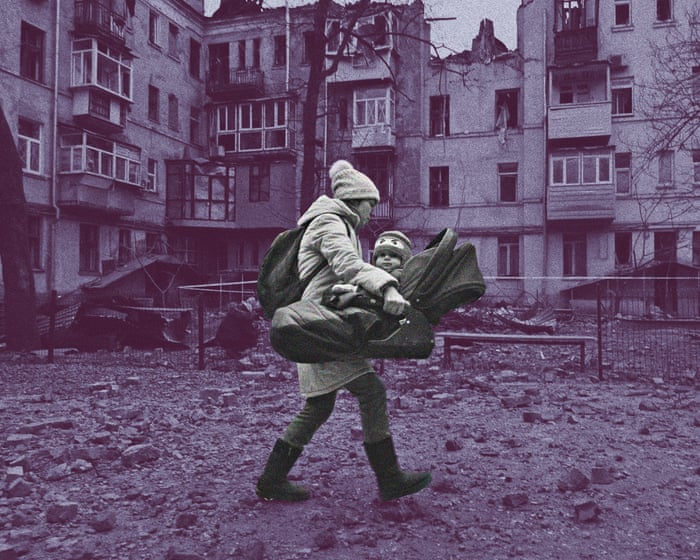One of the most shocking moments in Russia’s war on Ukraine was the bombing of a maternity hospital in Mariupol in March 2022. A widely shared photo showed a pregnant woman, Iryna Kalinina, being carried out on a stretcher, her face pale with shock, legs covered in blood, and a hand resting protectively on her belly. Behind her lay the ruins of the destroyed hospital. More than a dozen people, including women in labor, were wounded in the attack. Kalinina and her unborn child later died.
Since then, maternity care in Ukraine has faced relentless attacks. Over 2,000 medical facilities have been hit, including 81 that provided maternal and delivery care. Just last month, Diana Koshyk, who was seven months pregnant, was killed when a missile struck a maternity hospital in the Dnipropetrovsk region.
Over the past month, the Guardian visited three maternity hospitals near the front lines to document how Russia’s full-scale invasion has stripped women of their right to safe childbirth.
At each hospital, staff and patients face constant danger from drones, artillery, ballistic missiles, and the deliberate destruction of healthcare infrastructure. They risk their lives to bring new life into a country where deaths now outnumber births three to one.
Even as hopes for peace resurface, Russia’s brutal tactics have worsened Ukraine’s demographic crisis. Millions of women and children have fled the country, hundreds of thousands have been killed, and many of the women who remain are now afraid to become pregnant or give birth.
In 2024, Ukraine recorded the world’s lowest birth rate and highest mortality rate, according to the CIA World Factbook.
In Kharkiv, a hospital that once delivered around 1,000 babies a year saw that number drop to fewer than 440 last year. Two-thirds of women of childbearing age have left the city. The numbers would be even lower if not for women coming from other hospitals that have closed.
Just five days before the Guardian’s visit in late July, a drone strike damaged the maternity wing of Kharkiv’s main hospital. Windows shattered, spraying glass across patient beds. Pregnant women, new mothers, and one woman in active labor were rushed across the river to a perinatal center for emergency care. All were in shock, and the woman in labor required an urgent cesarean. Medical staff acted quickly, saving both her and the baby.
Such attacks have become routine in Kharkiv, which has faced intense bombardment since the earliest days of the war. In June, the city endured the highest number of attacks since the full-scale invasion began. Doctors at the perinatal center say they have delivered babies during air raids and performed surgeries while explosions shook the building.
The city bears deep scars from the war. Broken glass litters the streets outside the hospital, and two nearby buildings stand abandoned after being hit. The center’s windows are reinforced with sandbags and crisscrossed with tape to prevent shattering. Power outages are common—cesareans have been performed by torchlight in the past.
The stress on pregnant women is immense. Doctors report rising rates of medical complications linked to the constant fear and danger. As one patient, Olga Shevela, said: “I was worried the hospital could be targeted, but I had no choice but to give birth.”The hospital is dealing with trauma and emotional breakdowns. One new mother refused to take her baby home after learning her husband had been killed at the front. To help ease the fears of women who are afraid to even come to the hospital because of the risk of attack, the hospital has hired a psychologist.
When 30-year-old Olga Shevela went into labor, she had to travel to the hospital while Shahed drones flew overhead. “I was worried the hospital might be targeted, but I had no choice—I had to give birth,” she says, gently rocking her one-day-old son, Zahar. Just hours after delivery, nearly 20 explosions hit the city, forcing them into the hospital’s bomb shelter.
When air raid sirens sound, women in various stages of health hurry through the corridors toward the shelter. It’s too dangerous to use the elevator in case of an attack, so they manage the stairs instead. Some are followed by nurses holding IV drips, while others carry their newborns. Those in active labor, undergoing surgery, or recovering are too vulnerable to move and must stay behind.
Early in the war, births took place in a dusty basement. Now, it has been converted with beds and a delivery room. Though not sterile enough for surgery, it can accommodate births and has enough supplies to last three days.
Dasha Borisenko, 32, has had two miscarriages and is now living full-time at the hospital to protect her high-risk pregnancy—she isn’t due until January. She used to live in a village in the eastern Sumy region near the Russian border, where some of the worst fighting is now taking place. She hasn’t seen her husband for two weeks because they’re worried about military recruitment teams on the roads.
“I really want to have a child, but with this war, it’s hard to manage,” she says.
In Sloviansk, the population has dropped by half since the invasion began—from over 100,000 to about 53,000. Births at the hospital have fallen from more than 1,000 a year to around 550. That number is kept higher because the hospital now serves a wider area, as other maternity facilities have closed.
Liliia Eroshenko, 36, was heavily pregnant at home in July when she heard that three Shahed drones had struck the main building of Sloviansk hospital. She and her husband had waited three years to have a child, hoping for the war to end, but with no peace in sight, they “couldn’t wait forever.”
They feared the maternity building—just a short walk from the main hospital—would be the next Russian target. Four days after the bombardment, the maternity unit remains untouched, and Eroshenko is caring for her two-day-old daughter, Milana, who wriggles in a bassinet nearby.
With the city’s future so uncertain, she is thinking about fleeing to western Ukraine but worries nowhere is truly safe. One of her biggest fears is that her husband will be mobilized.
“There is no safe place left in Sloviansk,” she says. “We hear explosions every day.”
In the same room, 31-year-old Vitalii Chernetskyi holds his two-day-old daughter, Daria. Blinded in one eye, he is on indefinite leave after being injured at the front while his wife was pregnant. “Children are our happiness—they should be born,” he says.The hospital building that was hit now lies in ruins—charred, partially collapsed, with huge sheets of twisted metal roofing thrown meters away. When the Guardian visited, excavators were clearing rubble and shattered glass as the distant thud of artillery echoed in the background.
This is the last functioning maternity unit in the Ukrainian-controlled Donbas, the eastern industrial region of Donetsk and Luhansk that has been partly occupied since 2014. All others have closed, been destroyed, or are in occupied territory.
Located less than 20 miles from the shifting front line, women travel up to 100 miles to give birth here, facing threats from drones, artillery, missiles, and reconnaissance sabotage groups. People avoid public spaces due to frequent attacks and endure regular power cuts, along with espionage—during our visit, an alleged Russian agent was detained in Sloviansk for gathering military intelligence.
The hospital has lost several staff members to attacks on the city. Midwives report more premature births and a rise in cancers, particularly uterine cancer. “We saw a similar increase after 2014,” says Valentyna Hlushchenko, 62, director of obstetrics and gynecology. “Women breathe in particles from daily explosions,” she explains. “They also wait too long to seek help when something is wrong.”
In Kherson, the pre-invasion population of 280,000 has dwindled to less than a quarter. The maternity unit, which once handled 1,500 to 2,000 births a year, now sees only about 120. This year alone, around 100 people have been killed and 1,100 injured in the city.
In a windowless underground maternity hospital in Kherson, 35-year-old Kateryna Osetsymska sits in bed wearing a spotted hospital gown, her face wet with tears. Outside, heavy explosions rumble as munitions are exchanged across the river, with Russian forces just half a mile away.
Osetsymska was admitted a week ago for her safety. At 33 weeks pregnant, she is considered high risk due to uterine complications. “I’m certain it’s because of stress,” she says.
Since the full-scale invasion began, Kherson has been attacked with everything from tanks to guided aerial bombs, drones, and multiple rocket launchers. Maternity Hospital No. 2 has been damaged five times and now operates underground in a modernized basement equipped with delivery, surgery, and recovery rooms.
The day before the Guardian’s visit, an explosive dropped by a remotely guided “first-person view” (FPV) drone narrowly missed the hospital and struck the parking lot. “There isn’t a medical facility in Kherson that has been hit fewer than four or five times,” says Petro Marenkovskyi, head of obstetrics. “We are 100% confident Russia is deliberately targeting us.”
The city’s proximity to Russian forces means there is little warning before an attack. Artillery or mortar fire reaches its target in just three seconds, and if a Russian fighter jet is spotted, residents have only five minutes to find shelter from guided bombs.
FPV drones stalk residents, dropping explosives with chilling precision, often hitting civilians. Doctors report that—Even getting to work is extremely dangerous; we’ve been warned that a Russian reconnaissance drone is flying over the hospital during our visit.
The head of obstetrics in Kherson explains that the constant stress leads to a higher risk of miscarriages, more hemorrhages, and an increase in surgical procedures. Conditions were even worse during the nearly nine-month occupation in 2022, when people hid in their homes and women couldn’t access medical care, resulting in a sharp rise in stillbirths.
Osetsymska shares that she was pregnant with her youngest child during the occupation, unable to leave her village and with no access to doctors or medical care. “You can’t erase the horrible things we’ve been through in this war,” she says. “But my greatest hope is that my baby will live and have the chance to enjoy childhood.”
—
Contact us about this story
The best public interest journalism depends on firsthand accounts from those with direct knowledge. If you have information to share on this topic, you can contact us confidentially using the following methods:
Secure Messaging in the Guardian app
The Guardian app includes a tool for sending story tips. Messages are end-to-end encrypted and hidden within the app’s normal activity, making it impossible for anyone to detect that you are communicating with us or what you are saying.
If you don’t have the Guardian app, download it (iOS/Android) and go to the menu. Select ‘Secure Messaging’.
SecureDrop, instant messengers, email, telephone, and post
If you can safely use the Tor network without being monitored, you can send messages and documents to the Guardian via our SecureDrop platform.
For more details, our guide at theguardian.com/tips lists several secure ways to contact us and discusses the advantages and limitations of each method.
Illustration: Guardian Design / Rich Cousins
Frequently Asked Questions
Of course Here is a list of FAQs about Russias deliberate targeting of maternity hospitals and its impact on Ukraines birthrate crisis presented in a clear and natural tone
General Beginner Questions
1 Why is Russia targeting maternity hospitals in Ukraine
Military experts and international organizations state that these attacks are a deliberate strategy to terrorize the civilian population destroy the countrys future by targeting the most vulnerable and break the nations morale and will to resist
2 What is Ukraines birthrate crisis
Even before the fullscale invasion Ukraine had one of the lowest birth rates in Europe meaning not enough babies were being born to maintain its population The war has dramatically worsened this existing problem
3 How does bombing a hospital affect birth rates
It has a direct and indirect impact Directly it kills pregnant women newborns and medical staff Indirectly it destroys essential healthcare infrastructure and creates an environment of extreme fear making people feel it is too dangerous to have children
4 Can you give an example of a major attack on a maternity hospital
A welldocumented example is the bombing of the maternity hospital in Mariupol in March 2022 The attack received global condemnation and became a powerful symbol of the wars brutality against civilians
Intermediate ImpactFocused Questions
5 Besides the immediate deaths what is the longterm impact of these attacks
The longterm impact is the destruction of maternal healthcare systems in occupied and frontline areas This means fewer safe places for women to give birth leading to more pregnancy complications maternal deaths and a further decline in births for years to come
6 How does the stress of war affect pregnancy and birth rates
Extreme stress and trauma can lead to higher rates of miscarriage premature birth and infertility The constant fear and uncertainty also cause many couples to delay or decide against having children entirely
7 Has the number of births in Ukraine actually dropped since the invasion
Yes significantly Official data shows a sharp decline For example in the first year of the fullscale war the number of births fell by over 28 compared to the previous year accelerating the prewar population decline
8 Are these attacks considered a war crime
Yes absolutely International law including the Geneva Conventions explicitly protects civilians and civilian infrastructure like hospitals Deliberately attacking them is




